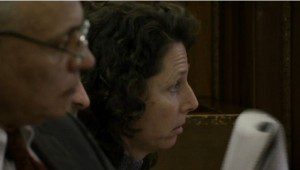By BOB DUNN
@BDGazette
NORTHAMPTON — A pathologist called in as an expert witness by Cara Lee Rintala’s defense team was grilled yesterday by the prosecution regarding Annamarie Cochrane Rintala’s time of death.
Jurors also heard the defense’s criticism of the thoroughness of the investigation into the killing during cross-examination of the lead investigator in the case.
Cara Rintala, 47, has pleaded not guilty to a charge of murder in connection with the strangulation death of her wife, Annamarie Cochrane Rintala, 37, in the basement of the couple’s Granby home on March 29, 2010.
Her first trial on the charge ended with a deadlocked jury and mistrial last March. Testimony in her retrial began Jan. 9.
Though the prosecution hasn’t rested its case yet, Dr. Jonathan Arden, a former medical examiner in Washington, D.C., and New York City, was allowed to testify for the defense yesterday to accommodate his schedule.
Questioned by Cara Rintala’s attorney, David Hoose, Arden said that, after reviewing the same information provided to now-retired state medical examiner Dr. Joann Richmond, there wasn’t enough information to reliably estimate the time of death.
Richmond testified earlier in the trial that Annamarie Rintala was dead six to eight hours or more when her body was found about 7:15 p.m.
Arden said the inclusion of “or more” in Richmond’s estimate left it too open-ended to be of much value. He noted that the condition of Annamarie Rintala’s body was relayed to Richmond over the phone, with information provided by paramedics and police who were called to the scene of her death.
Arden said first responders’ assertions that her body was stiff and her skin was cold weren’t of much value because those are subjective observations made by people who can recognize signs someone is dead, but aren’t experts in determining the extent of rigor mortis or estimating times of death.
Cross-examined by prosecutor Steven Gagne, Arden said people can still become experts in a particular field through experience and research even without some type of official certification.
Arden testified, for example, that he advertises himself in his consulting work as an expert in serial killers, though he holds no official certification as such.
Arden testified that from the information he reviewed in preparation for his testimony, it appeared Annamarie Rintala was in a state of “well-developed” rigor mortis, a state that could take three, four or up to six hours to develop.
Arden said that estimated range puts the possible time of death on both sides of 3 p.m., March 29, 2010.
“It’s not a perfect bell curve,” Arden said. “But it definitely falls on both sides of that line.”
The time of 3 p.m. is significant, Gagne said, because Cara Rintala told investigators that’s the last time she saw her wife before leaving the house with their daughter, before returning home shortly after 7 p.m. and finding the body in the basement.
Using a four-to-six-hour estimate to reach that level of rigor mortis, Gagne said, makes it more likely the time of death was before 3 p.m. than after.
Arden testified that physical exertion prior to death can speed up the onset of rigor mortis.
Hoose has suggested Annamarie Rintala was “in the fight of her life” in the basement before she succumbed to strangulation.
Questioned by Gagne, Arden said that exertion lasting 30 to 60 seconds probably wouldn’t be enough to significantly speed up rigor mortis.
Annamarie Rintala’s body had evidence of several blunt-force trauma wounds to her head that could have been severe enough to leave her dazed or even unconscious, making it easier for someone to strangle her without resistance, Gagne said.
Evidence overlooked?
Massachusetts State Police Detective Jamie Magarian, the lead investigator in the case, endured a lengthy and highly critical cross-examination by Hoose regarding the thoroughness of the investigation.
Hoose said items in and around the house that could have been significant were overlooked or never followed up on.
Hoose has suggested investigators had made up their minds from the start Cara Rintala was the only suspect in the case and ignored evidence that didn’t fit that theory.
Magarian said that despite Annamarie Rintala’s reputation for liking gadgets and technology, no computers, laptops, tablet computers or other electronics were found in the house.
A safe in the couple’s bedroom was never opened by investigators nor was any inquiry into its contents made, Magarian testified.
Hoose said a check of Annamarie Rintala’s bank records showed a purchase from a beauty supply store posted on the day she was killed, a Monday.
Magarian said the purchase only posted to her account that day, and the purchase could have been made over the weekend or earlier.
Magarian told the court he had made a note to follow up on the purchase, but never did.
Hoose said other items around the house were overlooked for evidence, including a shopping bag in Annamarie Rintala’s van, and a small plastic tub in the basement that apparently contained some type of tanning lotion, though there was no evidence either woman visited a tanning salon.
Magarian’s cross-examination is expected to continue Friday.
Presiding Judge Mary-Lou Rup told the jury consisting of 10 women and five men that they may get the case and begin their deliberations as early as Tuesday of next week.
Bob Dunn can be reached at [email protected].


